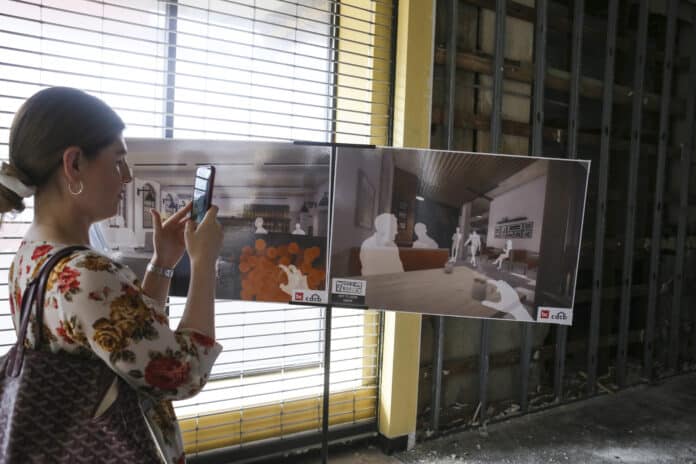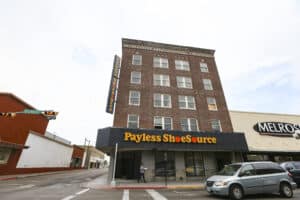
The nearly century-old Samano Building at 1158 E. Elizabeth St. in downtown Brownsville is being brought back to life thanks to a $12 million restoration/renovation project scheduled to begin in October.

(Denise Cathey/The Brownsville Herald)
The resurrected structure, which opened in 1925 as the First National Bank before it was purchased by the Samano family, will serve as affordable housing for those who are homeless or at risk of becoming so. The project is being led by Come Dream Come Build, formerly the Community Development Corporation of Brownsville.
When it reopens after an anticipated 12 to 14 months of construction, the former home of Samano Pharmacy will be rechristened Samano Studios and Armand’s Grocery, said CDCB Executive Director Nick Mitchell-Bennett, who conducted a top-to-bottom tour of the five-story structure on Tuesday. The upper floors of the building, which most recently housed Payless Shoes before that company went bankrupt, resemble a decades-old time capsule, though not for much longer.
The second through fifth floors will be transformed into 39 studio apartments with kitchenettes, plus a one-bedroom apartment for the on-site manager. The first floor corner at East 12th and East Elizabeth streets will be occupied by a 6,000-square-foot grocery store named for the late Father Armand Mathew, an Immaculate Conception priest who founded CDCB in 1974 to improve housing conditions for the city’s poor families.
“He told the story that he went out and started meeting the people in his parish, and he quickly realized that they needed a safe, sanitary place to live more than they needed his Mass schedule, and that’s a direct quote from him,” Mitchell-Bennett said. “We thought, appropriately, we would name the grocery store Armand’s.”
The first floor will also feature a small cafe/lunch counter accessible from a rear entrance and furnished with vintage booths and counter space from the building’s second floor, where Larry Holzman — the seller in the deal with CDCB — had a restaurant decades ago. Mitchell-Bennett said the purpose of the grocery store is to “bring food back down here” after H-E-B shuttered its downtown store in late 2019.
“What sealed the deal for us to do the grocery store was watching people who live in the Villa del Sol towers in their wheelchairs trying to wheel themselves to H-E-B, which is two miles away,” he said.
The store is also necessary to help people come downtown to live, Mitchell-Bennett said.
“People used to think I was nuts when I said downtown and West Brownsville would gentrify,” he said. “It’s happening and it’s happening fast. Between the Housing Authority of Brownsville and CDCB, we’re going to make sure that low-income working families have a foothold in downtown. Rich people can move here. I just want to make sure that working-class folks, low-income folks, can actually live here and be a part of this community.”
The city’s housing authority purchased Hotel El Jardin — just a block over on East Levee Street — for the purpose of transforming it into quality affordable housing with retail and a restaurant on the first floor and is awaiting news on tax credits.
Mitchell-Bennett said CDCB was first approached by the Valley Baptist Legacy Foundation about a “permanent supportive housing” project downtown, and that the foundation pledged $2.3 million right away to get things moving. No such housing exists south of San Antonio, even as Brownsville’s growth is accompanied by more homelessness downtown, he said.
The City of Brownsville and the Federal Home Loan Bank contributed $500,000 and $600,000 respectively, while the U.S. Treasury Department, through its Community Development Financial Institutions Fund’s Capital Magnet Fund, donated $340,000 to the project and the U.S. Conference of Mayors $50,000.
Samano Studios and Armand’s Grocery are also being made possible by nearly $4.2 million in federal and state historic tax credits. In order to be eligible for the credits, CDCB committed to preserve the mid-1920s look and character of the building — including original tile, trim, doors, windows and fixtures — during the restoration process, which is being done by Noble Texas Builders, headquartered in La Feria.
“The really cool thing is we found a picture of the interior of the bank from 1927, and in that picture you can see the light fixtures, the switches and everything, so it really made doing the interior design very easy,” Mitchell-Bennett said.
Plans also call for a hydroponic vegetable garden on the rooftop as well as a deck that will make for pleasant evening dining, according to Luis Murillo, BC Workshop design manager on the project. He said bringing the building back presents a number of challenges, among them how to retrofit the necessary air-conditioning equipment in a structure that was built before air conditioning.
“BC and the engineers have gotten really, really creative on how to make that happen,” Mitchell-Bennett said.



